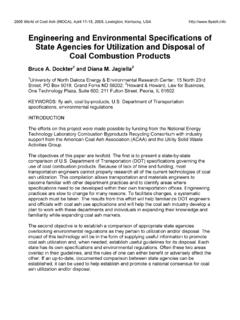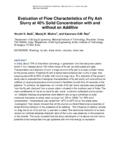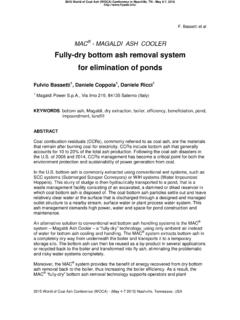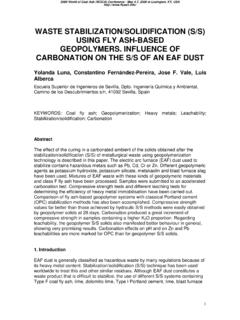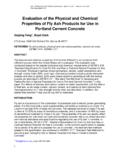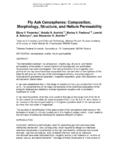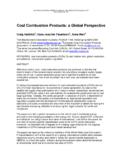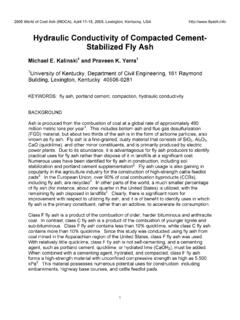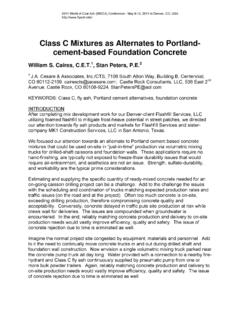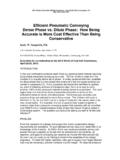Transcription of Use of ASTM Standards for Testing Freeze-Thaw ... - Fly Ash
1 Use of astm Standards for Testing Freeze-Thaw Resistance of fly ash Bricks Henry Liu1 and Jesse VanEngelenhoven1 1 Freight Pipeline Company, 2601 Maguire Blvd., Columbia, MO 65201, USA KEYWORDS: astm standard C67, brick , brick Testing , compressive strength, fly ash brick , Freeze-Thaw resistance, test method ABSTRACT Recently, a new type of brick made from 100% fly ash without firing the bricks in kilns was developed by Freight Pipeline Company. Since the technology is new and the product ( fly ash bricks) has not yet been mass-produced, there is no existing standard for this type of brick . However, because the brick is intended for use to replace clay bricks for buildings, it is reasonable to have the brick meet the same existing astm Standards for clay bricks used for buildings, namely C62 , C67 and C216.
2 While C62 and C216 specify the minimum requirements for clay bricks used for buildings, C67 specifies how clay bricks must be tested to satisfy the requirements. Problems occur in Testing the Freeze-Thaw resistance of fly ash bricks according to C67 not only because C67 was designed for Testing fired clay bricks instead of non-fir ed fly ash bricks but also due to some arbitrariness in the standard subject to misinterpretation. In this research, the C67 method was modified somewhat to make it more meaningful and less arbitrary for Testing fly ash bricks. Experiments were conducted to evaluate the difference in Freeze-Thaw cycles for fly ash bricks tested according to modified and unmodified methods.
3 Test results showed that the modified test method yields somewhat more meaningful and conservative results than the unmodified method. Due to this, and due to the fact that the modified method is much easier and less time-consuming to use than the unmodified C67 method, the modified method is currently used in research and development for evaluating the Freeze-Thaw resistance of fly ash bricks. It may also form the foundation or blueprint of a future astm Standard for Testing fly ash bricks. 1. INTRODUCTION In the last 4 years (since 2005), a new type of brick , made from Class C fly ash without using any cement or another binder or aggregate, has been developed by the Freight Pipeline Company (FPC) under the sponsorship of the National Science Foundation (NSF) [1, 2]1 1 Numerals in [ ] represent corresponding items in REFERENCES.
4 Since the technology is new and has not yet been used commercially, there is no existing standard for this type of brick to meet. However, because the fly ash 2009 World of Coal Ash (WOCA) Conference - May 4-7, 2009 in Lexington, KY, 2 brick is intended for use to replace clay brick for buildings, it is reasonable to expect that the fly ash brick should meet the same existing Standards for clay bricks used for buildings, which are astm Standards C62 [3], C67 [4] and C216 [5]. Note that both astm C62 and C216 specify the minimum requirements for clay bricks used for buildings. While C62 is for bricks where their appearance is not a requirement, C216 is for facing bricks of which both appearance and str uctural properties are specified.
5 Otherwise, both are identical in terms of the requirements on the structural properties of bricks. For instance, both require that for bricks used in severe weather regions ( , in places where freezing occurs in winter), the average compressive strength of 5 brick samples must be at least 3,000 psi, and the average Freeze-Thaw resistance of the bricks must be at least 50 Freeze-Thaw cycles. Both C62 and C216 only specify the requirements for bricks without showing how the bricks must be tested for various properties to satisfy the requirements. The test methods, on the other hand, are specified in detail in C67. Therefore, C67 deals with test methods used to determine whether bricks meet the requirements of C62 and C216 or not.
6 2. PROBLEMS WITH astm C67 In following astm C67 methods to test fly ash bricks, several problems exist. The first problem stems from the fact that C67 was designed for Testing fired clay bricks instead of non-fired fly ash bricks, which have different characteristics. For instance, C67 requires that test samples (half bricks) be first dried in a ventilated oven for 24 hours or more at 230 to 239 oF before they are to be tested for compressive strength and Freeze-Thaw resistance. Note that oven drying does not change the properties of fired clay bricks because the bricks were pre-heated to over 2,000 oF in kilns during manufacturing.
7 Such high temperature kiln firing has vitrified the clay brick into a glass-like material which is inert to heating in the oven. In contrast, fly ash bricks being manufactured either at room temperature or at slightly above room temperature are affected by high temperature heating in oven. For instance, tests conducted in this NSF project showed that the compressive strength of fly ash bricks that were dried in oven according to astm C67 is approximately 20% higher than the compressive strength of room-dried fly ash bricks. The Freeze-Thaw resistance of fly ash bricks, on the other hand, is adversely affected by such oven drying.
8 Therefore, it is inappropriate to use the compressive strength and Freeze-Thaw resistance of oven-dried fly ash bricks because in building construction bricks will never be heated to much above room temperature (except when a building is on fire), and hence will have a significantly different compressive strength and Freeze-Thaw resistance than given by the test results based on oven-dried fly ash bricks. This shows that fly ash bricks should not be heated in oven before tested for compressive strength and Freeze-Thaw resistance. A second problem with astm C67 is that the Freeze-Thaw test conducted according to C67 is not only slow and cumbersome but also imprecisely specified in the Standard.
9 As a result of the ambiguity of the Standard, different individuals or laboratories using the 3 same standard to test the same bricks will often yield very different results and outcomes. As stated by Grimm [6], The current standard Freeze-Thaw test (as specified in C67) is expensive, time-consuming, unrealistic, and incapable of certain identification of nondurable bricks. Problems with the Freeze-Thaw test conducted according to astm C67 have prompted astm to allow the use of water absorption test results to determine the durability ( Freeze-Thaw resistance) of clay bricks. According to C62 and C216, if bricks in severe weather regions have 5-hour hot water absorption value of less than 17% and have saturation coefficient less than (78%) -- based on the average from 5 brick samples -- the bricks are deemed to be Freeze-Thaw resistant and need not be subjected to the Freeze-Thaw test.
10 This compromise of astm has brought great relief to clay brick manufacturers, distributors and users. As a result, today few if any contractor or manufacturer test each batch of bricks brought to any construction site for freeze thaw. Instead, they run the water absorption tests which are much easier and faster to do. However, research conducted in both United Kingdom and United States has shown poor correlation between the absorption requirements of C62/C216 and the Freeze-Thaw cycle requirements under the same Standards [7]. For instance, Robinson, Holman and Edwards [8] showed that using the water absorption standard of C62/C216 to determine durability would accept as many as of bricks that could not pass the required Freeze-Thaw cycles, whereas of the bricks that have passed the required Freeze-Thaw cycles would not pass the absorption criteria.
